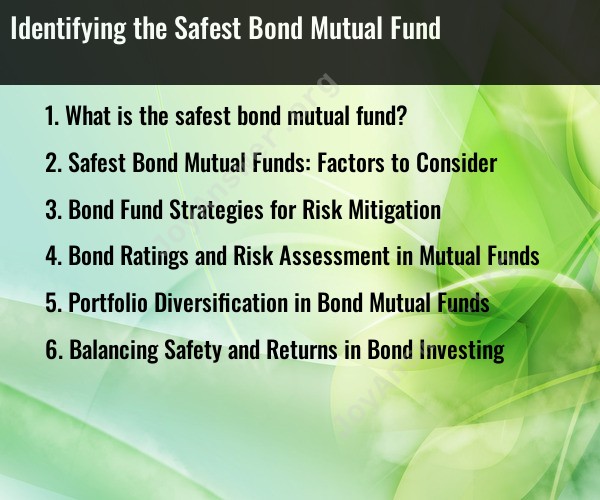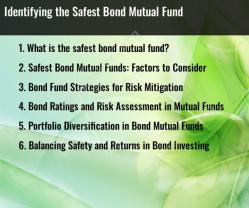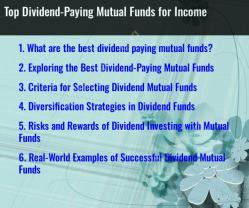What is the safest bond mutual fund?
Determining the "safest" bond mutual fund depends on your definition of safety and your investment objectives. In the world of mutual funds, safety typically refers to preserving capital and minimizing the risk of losing your principal investment. Bond mutual funds are generally considered less risky than equity (stock) mutual funds, but they still carry some level of risk. Here are some factors to consider when evaluating the safety of bond mutual funds:
Investment Grade Bonds: Look for bond mutual funds that primarily invest in investment-grade bonds. These are bonds issued by stable, creditworthy entities (e.g., government bonds or highly-rated corporate bonds) and are considered less risky compared to lower-rated or high-yield bonds.
Diversification: A well-diversified bond mutual fund spreads its investments across various bond types, maturities, and issuers. Diversification can help mitigate risks associated with individual bonds or sectors.
Low Expense Ratio: Choose funds with low expense ratios. Lower expenses mean more of your investment goes toward earning potential returns.
Short to Intermediate-Term Bonds: Short to intermediate-term bond funds tend to be less sensitive to interest rate changes compared to long-term bond funds. They may provide more stability in terms of preserving capital.
Historical Performance: Examine the fund's historical performance and how it has performed during various market conditions, especially during economic downturns or periods of rising interest rates.
Credit Quality: Assess the credit quality of the bonds held in the fund. Funds with a focus on high-quality, investment-grade bonds tend to be safer.
Duration: Consider the fund's duration, which measures its sensitivity to interest rate changes. Lower duration indicates less sensitivity.
Stable Management: Look for funds managed by experienced and reputable portfolio managers or management teams.
Expense Ratio: A low expense ratio means that less of your returns are eaten up by fees. Look for funds with competitive expense ratios.
Risk Tolerance: Consider your own risk tolerance and investment goals. The "safest" fund for you may vary based on your risk tolerance and financial objectives.
No bond mutual fund is entirely risk-free, but some categories of bond funds, such as U.S. Treasury bond funds or high-quality corporate bond funds, are generally considered safer than others. Keep in mind that while they offer more stability compared to stocks, bond mutual funds are still subject to interest rate risk, credit risk, and market fluctuations.
It's advisable to consult with a financial advisor or investment professional to select a bond mutual fund that aligns with your financial goals and risk tolerance. Additionally, you should carefully read the fund's prospectus, which provides detailed information about the fund's objectives, holdings, and risks.
Safest Bond Mutual Funds: Factors to Consider
When choosing bond mutual funds, considering factors that contribute to their safety is crucial. Here are key aspects to evaluate:
Credit Quality: Invest in funds with high credit ratings, indicating a lower risk of default. Ratings range from AAA (highest) to D (lowest).
Fund Duration: Opt for funds with shorter durations, meaning the bonds mature sooner, reducing interest rate sensitivity.
Fund Diversification: Choose funds with a diverse range of bonds across different sectors and issuers to minimize exposure to any single entity or industry.
Expense Ratio: Seek funds with low expense ratios, which represent the annual fees charged by the fund, to maximize returns.
Bond Fund Strategies for Risk Mitigation
To mitigate risk when investing in bond mutual funds, consider these strategies:
Laddered Maturities: Invest in bonds with staggered maturity dates to spread out cash flows and reduce reinvestment risk.
Dollar-Cost Averaging: Invest fixed amounts at regular intervals, regardless of market fluctuations, to lower the average purchase price.
Active Management: Consider actively managed funds where experienced managers make informed decisions based on market conditions.
Index Funds: Opt for index funds that passively track a specific bond index, offering lower fees and diversification.
Bond Ratings and Risk Assessment in Mutual Funds
Bond ratings are crucial indicators of risk in bond mutual funds. Ratings agencies like S&P Global Ratings, Moody's Investors Service, and Fitch Ratings assign credit ratings to bonds. Higher ratings indicate lower default risk and vice versa.
Investment-Grade Bonds (BBB and above): Lower risk of default, suitable for conservative investors.
High-Yield Bonds (BB and below): Higher risk of default, but offer potentially higher returns.
Non-Investment-Grade Bonds (BB and below): Also known as "junk bonds," carry the highest risk of default, but offer the potential for high returns.
Portfolio Diversification in Bond Mutual Funds
Diversifying your bond portfolio across different types of bonds, sectors, and issuers can help reduce overall risk. Consider:
Government Bonds: Issued by governments, considered the safest type of bond.
Corporate Bonds: Issued by corporations, offer higher yields but carry more default risk.
Municipal Bonds: Issued by state and local governments, may offer tax benefits.
International Bonds: Issued by foreign governments or corporations, offer exposure to different markets and currencies.
Balancing Safety and Returns in Bond Investing
Balancing safety and returns in bond investing requires careful consideration of risk tolerance and investment goals.
Conservative Investors: Prioritize safety, invest in investment-grade bonds with short durations and low expense ratios.
Moderate Investors: Seek a balance between risk and return, consider a mix of investment-grade and high-yield bonds with varying durations.
Aggressive Investors: Willing to take on more risk in pursuit of higher returns, may invest in high-yield or non-investment-grade bonds with longer durations.
Remember, investment decisions should align with your financial situation, risk tolerance, and long-term goals. Consult a financial advisor for personalized advice.



